2003 CHEVROLET ASTRO steering wheel
[x] Cancel search: steering wheelPage 71 of 386
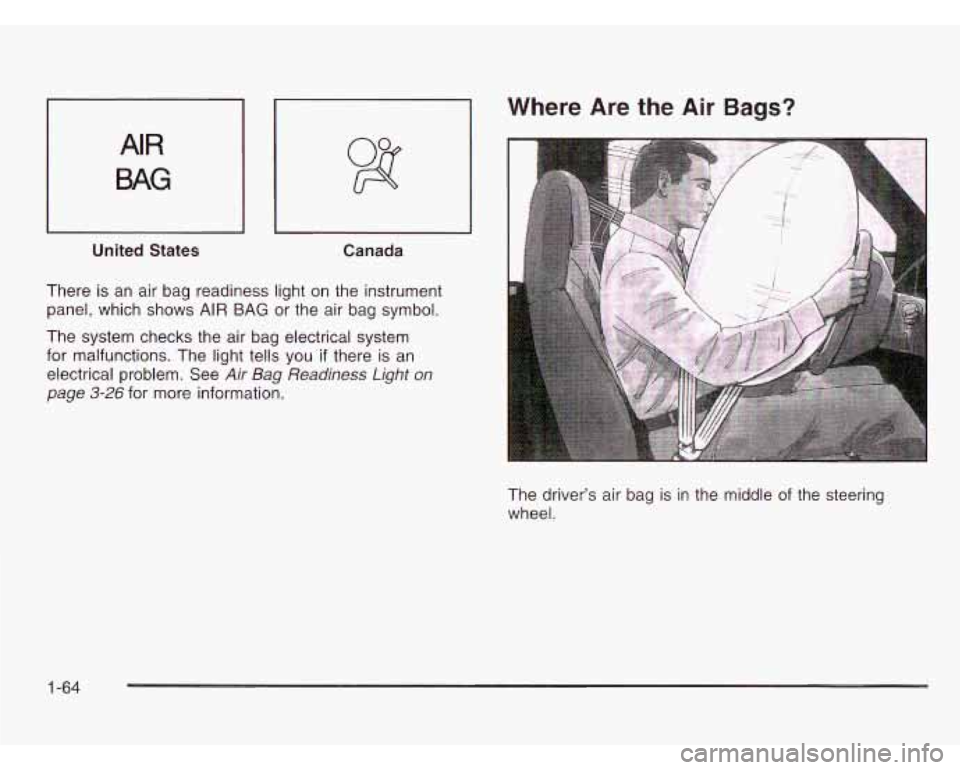
AIR
BAG
United States Canada
There is an air bag readiness light on the instrument
panel, which shows AIR BAG or the air bag symbol.
Where Are the Air Bags?
The system checks the air bag electrical system
for malfunctions. The light tells you
if there is an
electrical problem. See
Air Bag Readiness Light on
page
3-26 for more information.
The driver’s air bag is in the middle
of the steering
wheel.
1-64
Page 72 of 386
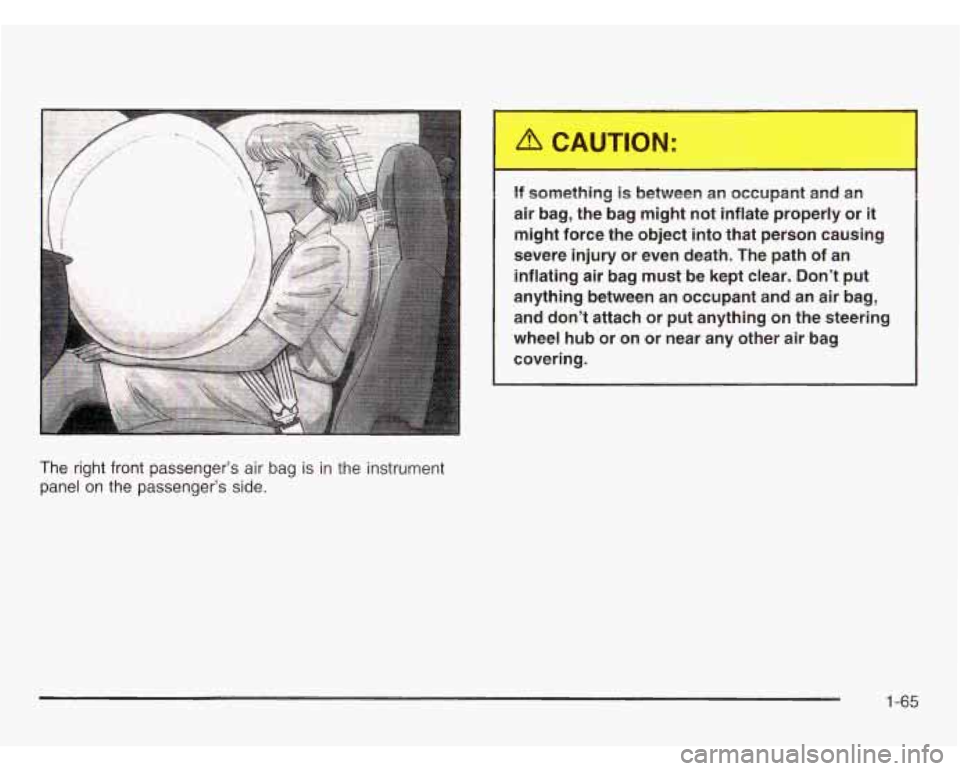
The right front passenger’s air bag is in the instrument
panel on the passenger’s side.
16 something is between an occupant and an
air bag, the bag might not inflate properly or
it
might force the object into that person causing
severe injury or even death. The path of an
inflating air bag must be kept clear. Don’t put
anything between an occupant and an air bag,
and don’t attach or put anything on the steering
wheel hub or on or near any other air bag
covering.
1-65
Page 74 of 386
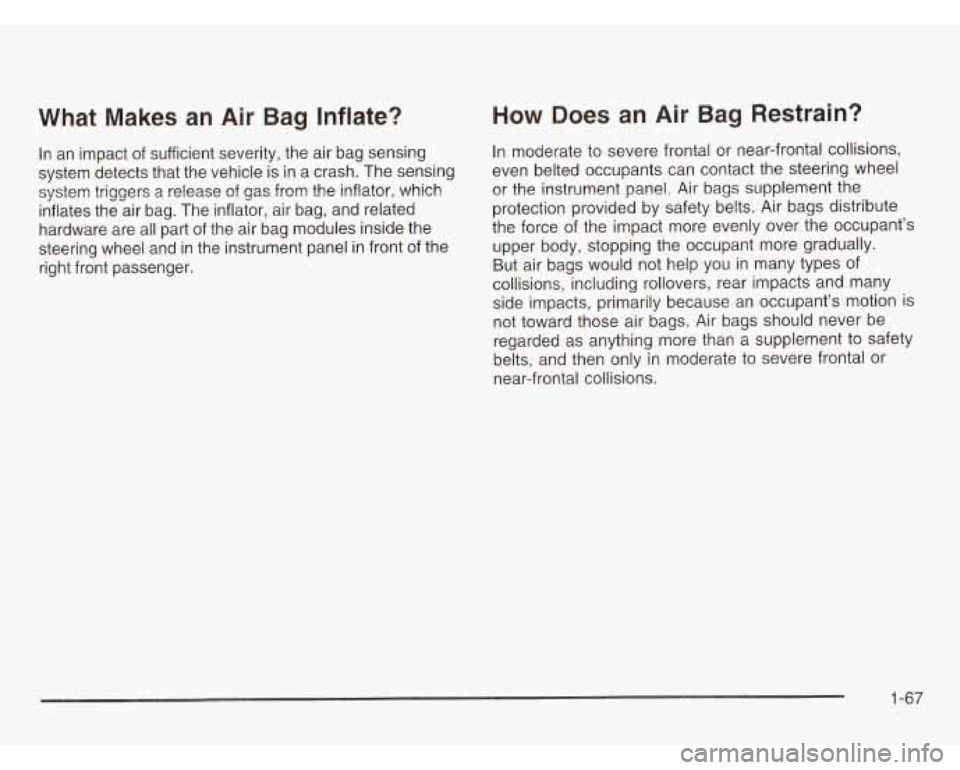
What Makes an Air Bag Inflate?
In an impact of sufficient severity, the air bag sensing
system detects that the vehicle
is in a crash. The sensing
system triggers a release of gas from the inflator, which
inflates the air bag. The inflator, air bag, and related
hardware are all part of the air bag modules inside the
steering wheel and in the instrument panel in front of the
right front passenger.
How Does an Air Bag Restrain?
In moderate to severe frontal or near-frontal collisions,
even belted occupants can contact the steering wheel
or the instrument panel. Air bags supplement the
protection provided by safety belts. Air bags distribute
the force of the impact more evenly over the occupant’s
upper body, stopping the occupant more gradually.
But air bags would not help you in many types
of
collisions, including rollovers, rear impacts and many
side impacts, primarily because an occupant’s motion is
not toward those air bags. Air bags should never be
regarded as anything more than a supplement to safety
belts, and then only in moderate to severe frontal or
near-frontal collisions.
1-67
Page 75 of 386
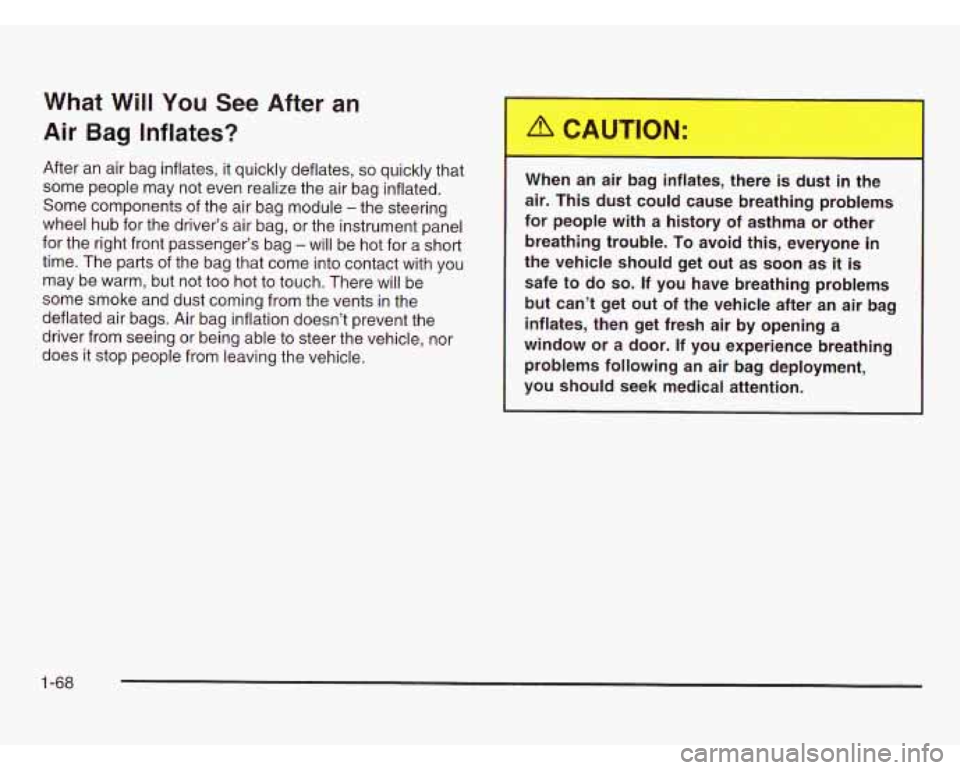
What Will You See After an
Air Bag Inflates?
After an air bag inflates, it quickly deflates, so quickly that
some people may not even realize the air bag inflated.
Some components of the air bag module -the steering
wheel hub for the driver’s air bag, or the instrument panel
for the right front passenger’s bag -will be hot for a short
time. The parts of the bag that come into contact with you
may be warm, but not too hot to touch. There will be
some smoke and dust coming from the vents in the
deflated air bags. Air bag inflation doesn’t prevent the
driver from seeing or being able to steer the vehicle, nor
does it stop people from leaving the vehicle. When
an air bag inflates, there is dust in the
air. This dust could cause breathing problems
for people with a history
of asthma or other
breathing trouble. To avoid this, everyone in
the vehicle should get out as
soon as it is
safe to do so. If you have breathing problems
but can’t get out of the vehicle after an air bag
inflates, then get fresh air by opening
a
window or a door. If you experience breathing
l problems following an air bag deployment,
you should seek medical attention.
1-68
Page 76 of 386
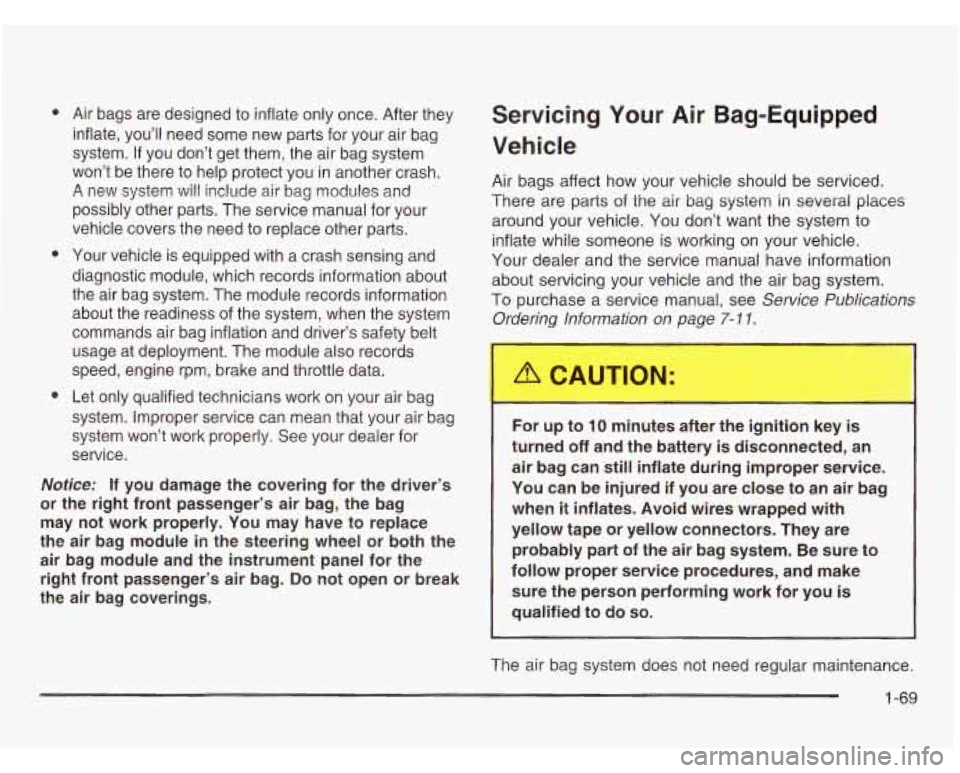
e
e
e
Air bags are designed to inflate only once. After they
inflate, you’ll need some new parts for your air bag
system.
If you don’t get them, the air bag system
won’t be there to help protect you in another crash.
A new system will include air bag modules and
possibly other parts. The service manual for your
vehicle covers the need to replace other parts.
Your vehicle is equipped with a crash sensing and
diagnostic module, which records information about
the air bag system. The module records information
about the readiness of the system, when the system
commands air bag inflation and driver’s safety belt
usage at deployment. The module also records
speed, engine rpm, brake and throttle data.
Let only qualified technicians work on your air bag
system. Improper service can mean that your air bag
system won’t work properly. See your dealer for
service.
Notice: If you damage the covering for the driver’s
or the right front passenger’s air bag, the bag
may not work properly. You may have to replace
the air bag module in the steering wheel or both the
air bag module and the instrument panel for the
right front passenger’s air bag.
Do not open or break
the air bag coverings.
Servicing Your Air Bag-Equipped
Vehicle
Air bags affect how your vehicle should be serviced.
There are parts of the air bag system in several places
around your vehicle. You don’t want the system
to
inflate while someone is working on your vehicle.
Your dealer and the service manual have information
about servicing your vehicle and the air bag system.
To purchase a service manual, see
Service Publications
Ordering Informqtion on page
7-1 1.
For up to 10 minutes after the ignition key is
turned off and the battery is disconnected, an
air bag can
still inflate during improper service.
You can be injured if you are close to an air bag
when
it inflates. Avoid wires wrapped with
yellow tape or yellow connectors. They are
probably part of the air bag system. Be sure to
follow proper service procedures, and make sure the person performing work for you
is
qualified to do so.
The air bag system does not need regular maintenance.
1-69
Page 98 of 386
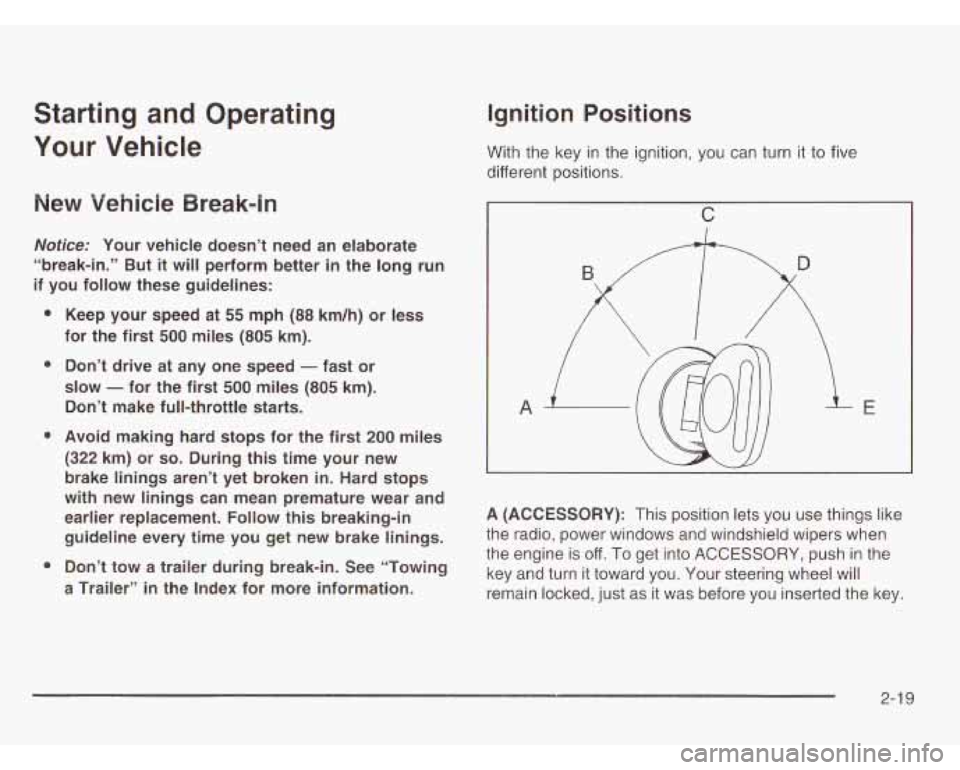
Starting and Operating
Your Vehicle
New Vehicle Break-in
Nofice: Your vehicle doesn’t need an elaborate
“break-in.” But
it will perform better in the long run
if you follow these guidelines:
e
e
Keep your speed at 55 mph (88 km/h) or less
for
the first 500 miles (805 km).
Don’t drive at any one speed
- fast or
slow
- for the first 500 miles (805 km).
Don’t make full-throttle starts.
Avoid making hard stops for the first
200 miles
(322 km) or so. During this time your new
brake linings aren’t yet broken in. Hard stops
with new linings can mean premature wear and
earlier replacement. Follow this breaking-in guideline every time you get new brake linings.
Don’t tow a trailer during break-in. See “Towing
a Trailer” in the Index for more information.
Ignition Positions
With the key in the ignition, you can turn it to five
different positions.
C
A
A (ACCESSORY): This position lets you use things like
the radio, power windows and windshield wipers when
the engine is off.
To get into ACCESSORY, push in the
key and turn it toward you. Your steering wheel will
remain locked, just as it was before you inserted the key.
2-1 9
Page 99 of 386
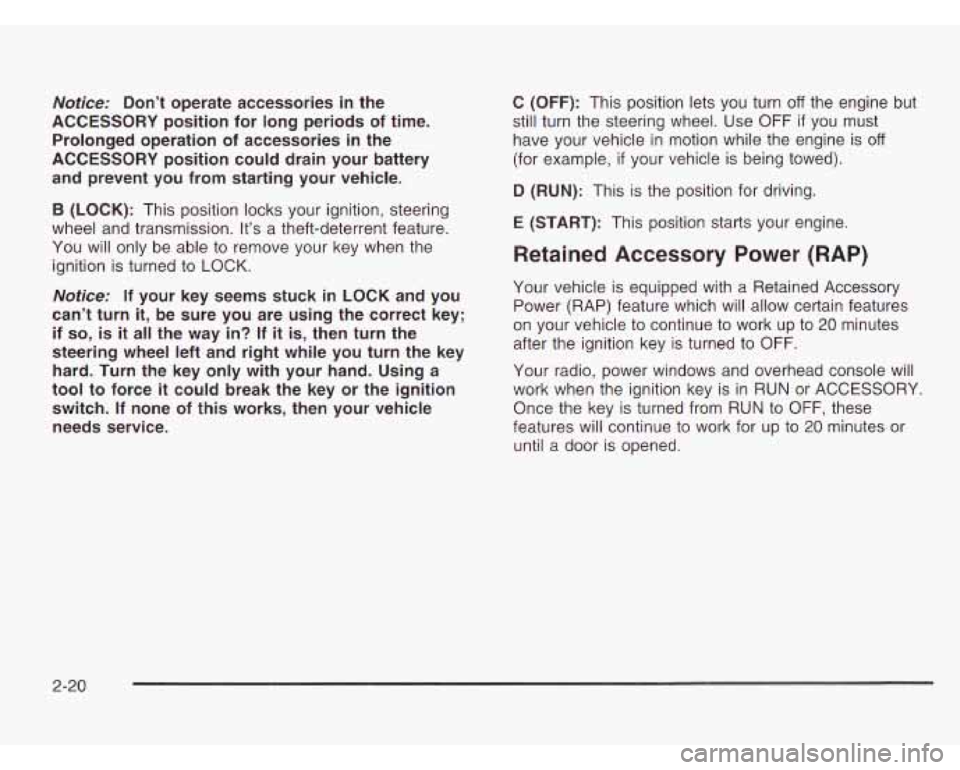
Notice: Don’t operate accessories in the
ACCESSORY position for long periods of time.
Prolonged operation of accessories in the
ACCESSORY position could drain your battery
and prevent you from starting your vehicle.
B (LOCK): This position locks your ignition, steering
wheel and transmission. It’s a theft-deterrent feature.
You will only be able to remove your key when the
ignition is turned to LOCK.
Notice: If your key seems stuck in LOCK and you
can’t turn
it, be sure you are using the correct key;
if
so, is it all the way in? If it is, then turn the
steering wheel left and right while you turn the key hard. Turn the key only with your hand. Using a
tool to force
it could break the key or the ignition
switch. If none of this works, then your vehicle needs service.
C (OFF): This position lets you turn off the engine but
still turn the steering wheel. Use
OFF if you must
have your vehicle in motion while the engine is
off
(for example, if your vehicle is being towed).
D (RUN): This is the position for driving.
E (START): This position starts your engine.
Retained Accessory Power (RAP)
Your vehicle is equipped with a Retained Accessory
Power (RAP) feature which will allow certain features
on your vehicle to continue to work up to
20 minutes
after the ignition key is turned
to OFF.
Your radio, power windows and overhead console will
work when the ignition key is in RUN or ACCESSORY
Once the key is turned from RUN to
OFF, these
features will continue to work for up to
20 minutes or
until a door is opened.
2-20
Page 105 of 386
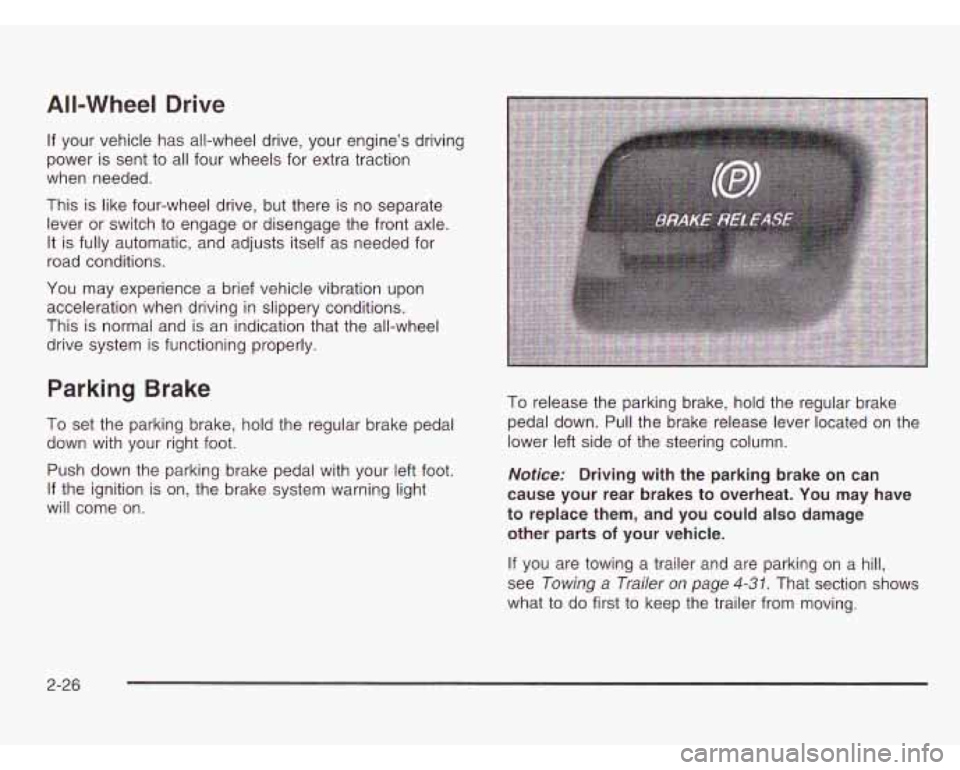
All-Wheel Drive
If your vehicle has all-wheel drive, your engine’s driving
power is sent
to all four wheels for extra traction
when needed.
This is like four-wheel drive, but there is no separate
lever or switch to engage or disengage the front axle.
It is fully automatic, and adjusts itself as needed for
road conditions.
You may experience a brief vehicle vibration upon
acceleration when driving in slippery conditions.
This is normal and is an indication that the all-wheel
drive system is functioning properly.
Parking Brake
To set the parking brake, hold the regular brake pedal
down with your right foot.
Push down the parking brake pedal with your left foot.
If the ignition is on, the brake system warning light
will come on.
To release the parking brake, hold the regular brake
pedal down.
Pull the brake release lever located on the
lower left side of the steering column.
Notice: Driving with the parking brake on can
cause your rear brakes to overheat. You may have
to replace them, and you could also damage
other parts
of your vehicle.
If you are towing a trailer and are parking on a hill,
see
Towing a Trailer on page 4-31. That section shows
what to do first to keep the trailer from moving.
2-26